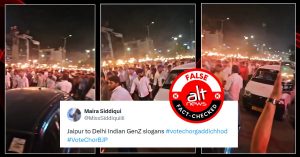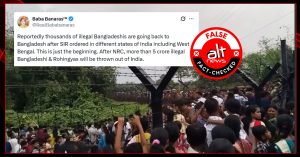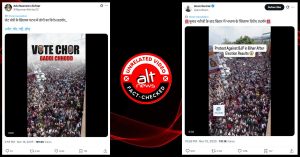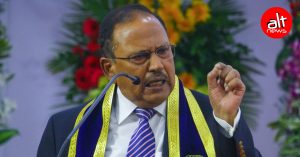Ramadan, the ninth month of the Islamic calendar, is considered one of the holiest periods for Muslims across the world. It is believed that this was when sacred verses of the Quran were revealed to Prophet Mohammad. Followers of the faith commemorate this period by fasting from dawn to dusk and channeling their focus towards devotion and spirituality. The sighting of the Moon marks the culmination of the month-long period of abstinence.
In India, however, Ramadan comes with fears that simmering communal tensions could rupture at the slightest provocation, spiralling into violence, targeted harassment and further polarization of communities. A recent report by the Centre for Study of Society and Secularism found that most communal riots last year were triggered during religious festivals or processions. So far, 2025 seems no different.
Also Read | ‘Body in fridge’ tableau in Munger Shivratri rally: Islamophobia & hate trounced devotion & piety?
The month of Ramadan or Ramzan began on March 1 and concluded on March 31. This year, the Hindu festival of colours, Holi, fell during this period (March 13-14), sparking fears that it would bring out the worst in radical fringe elements who would go to extremes to incite the ‘other’. It’s safe to say that this was not far-fetched thinking.
Pre-Holi Warnings Set the Tone
A week before Holi, a police official in Uttar Pradesh’s Sambhal stirred up a controversy by urging Muslims to stay indoors on the day of the Hindu festival. This year, Holi happened to be on a Friday, which is also the day Muslims offer the Jumma Namaz or special weekly prayers. Note that Sambhal has been a hotbed of communal tensions over the past several months amid disputes over the site of the Shahi Jama Masjid.
“Jumma comes 52 times a year, but Holi comes once. If someone finds the colors of Holi offensive or profane, they should stay indoors and offer their prayers there,” Sambhal’s circle officer Anuj Chaudhary said.
#WATCH | Sambhal, UP: After the Peace Committee Meeting held ahead of Holi, Sambhal CO Anuj Kumar Chaudhary says, “Holi and ‘Jumma’ (Friday) fall on the same day… We had a meeting with people of all communities… It is a festival of harmony. Hindus and Muslims will celebrate… pic.twitter.com/sTqb52Jwhg
— ANI (@ANI) March 6, 2025
His comments, which came on March 6, inadvertently set the tone for how things would play out through the month. As this story and the many instances we have documented here show, Muslims were repeatedly asked to confine themselves indoors or steer clear of public spaces. All this while revelries by other groups were being carried out in public.
Alt News has documented in detail how several Hindutva groups tried to throw colours on Mosques of worship defiled on the day of Holi in a brazen display of Hindutva superiority. Read Holi 2025: Consent goes for a toss again; violence against women, religious minorities takes front seat.
Meanwhile, Uttar Pradesh Chief Minister Yogi Adityanath extended his support to the sermon by the Sambhal circle officer. At an India Today conclave on March 8, Adityanath said that while the manner in which Chaudhary spoke “may have hurt a few people, but he spoke the truth and people should accept it”.
होली साल में एक बार पड़ती है, जुमे की नमाज तो हर सप्ताह पढ़नी है…
आवश्यक नहीं है कि वह व्यक्ति मस्जिद में ही जाए, अगर जाना ही है तो रंग से परहेज न करे… pic.twitter.com/cTba047I8k
— Yogi Adityanath (@myogiadityanath) March 8, 2025
Inspired by Yogi and the circle officer, a BJP MLA from Bihar, Haribhushan Thakur Bachaul, too reiterated the same logic: “If they have such a problem, they should stay indoors. This is essential for maintaining communal harmony.” Bachaul, who represents the Bisfi assembly constituency, “appealed” to Muslims that “There are 52 Jummas (Fridays) in a year. One of them coincides with Holi. So, they should let Hindus celebrate the festival and not take offence if colours are smeared on them,” he said.
बिहार बीजेपी विधायक हरिभूषण ठाकुर बचौल ने मुस्लिमों से अपील की है कि होली के दिन वे घरों में ही रहें, सुनिए और क्या कह रहे हैं बीजेपी विधायक- #Holi2025 #BJP #BiharNews #Muslim pic.twitter.com/3ehaZj7Nvy
— NBT Bihar (@NBTBihar) March 10, 2025
A BJP leader from Uttar Pradesh, Raghuraj Singh, went a step further. He suggested that Muslim men cover themselves in “tarpaulin hijabs” if they wanted to avoid being splattered with colours when they step out from their homes for prayers on Holi.
“For the followers of Sanatan Dharma, the festival of Holi comes just once in a year and to expect them to not to play Holi at some restricted areas near mosques is not a feasible solution,” he said, adding that Muslim women covered themselves with Hijabs and mosques too were covered with tarpaulins preemptively, so Muslim men could don “tarpaulin hijabs” as precaution since the range of a “pichkari” (water gun) was beyond their control.
#WATCH | Aligarh: UP Minister Dr Raghuraj Singh says, ” They can offer Namaz, we have no issues but they can’t say things like colour shouldn’t fall within the distance of 20 m or 25 m from them because ‘Pichkari’ has no measurement…it is festival of our God…those who have… pic.twitter.com/pMgATt1a14
— ANI (@ANI) March 11, 2025
After such statements, the chairperson of the Islamic Centre of India, Maulana Khalid Rasheed Farangi Mahali, appealed that timings of the Friday prayers be deferred for Muslims. In UP, prayer timings had to be officially pushed by an hour in the afternoon in the interest of harmony.
The stand by the state machinery, especially in UP, was clear. One group’s right to celebrate their festival takes precedence. Others should practise privately, indoors.
Should not be Seen, Should not be Heard
Not only was one group being asked to confine themselves to a space, but presenting their faith publicly in any way was turning out to be an issue.
Here’s one example from Uttar Pradesh again. On March 6, a controversy erupted in Manakpur Bajaria village–located within the Syed Nagar Chowki limits of Tanda police station in Rampur—after a loudspeaker was used at a mosque to announce the commencement of Iftar, which is the meal eaten to break the fast during Ramadan. The use of speakers prompted protests from Hindutva groups, who filed a formal complaint. In response, the police swiftly intervened, arresting nine individuals, including the mosque’s Imam, citing concerns over public order and potential disturbance. Authorities also removed the loudspeaker, calling it a “new tradition.”
मस्जिद से लाउडस्पीकर पर रोजा खोलने का ऐलान, दूसरे समुदाय के लोगों ने पुलिस से कि शिकायत, इमाम समेत 9 लोग गिरफ्तार। रामपुर के मानकपुर बंजारिया गांव का मामला… pic.twitter.com/hKfnZiTcmD
— Ashraf Hussain (@AshrafFem) March 6, 2025
On the whole issue, Additional Superintendent of Police, Atul Kumar Shrivastava, said that the action was taken after “dispute arose among the two groups after the announcement was made through the loudspeaker at the mosque.” “Immediate actions were taken and nine individuals were arrested to maintain law and order,” he confirmed.
Here’s another example from UP. In the Chaudasai area of Sambhal on March 8, the police swiftly registered a case against an Imam for allegedly using a loudspeaker at a mosque for the “azaan”. The volume, according to reports, exceeded the prescribed decibel limit.
Interestingly, in Sambhal itself, Right-wing groups took out a procession where they blared music on loudspeakers on Holi right outside a mosque. We have documented this here.
Culmination of Violence
One could dismiss the above examples as a mere show of dominance or strength by one group that, to put it mildly, are in poor taste. However, it didn’t stop at that.
On March 8, Bajrang Dal workers barged into Rishikul Ayurvedic College in Haridwar, Uttarakhand, protesting against Muslim students organising an Iftar party on campus. According to the Hindutva activists, the party was a front for a “conspiracy” being hatched under “Islamic Jihad”. They claimed municipal corporation bylaws prohibit non-Hindus from organising such events in the religious city.
On March 9, the Indian men’s cricket team lifted the ICC Champions Trophy. People gathered in huge numbers to celebrate the win across the country. In Madhya Pradesh’s Mhow, clashes broke out near the Jama Masjid after some fans celebrating the team’s win took out a rally and allegedly provoked Muslim worshippers who were performing the night-time Ramadan prayers (Taraaweeh) by chanting ‘Jai Shree Ram’ and bursting firecrackers. According to reports, shops and vehicles were torched, and as the victory rally approached the mosque area, a large group of individuals began pelting stones at worshippers. Later, 13 people were arrested and several FIRs registered.
Below is an account of the outbreak. (Archive)
MP : इंदौर के महू में कल रात भारत की जीत पर विजय जुलूस निकालने के दौरान दो गुट आमने–सामने आए। कई दुकानों–वाहनों में आग लगाई, पेट्रोल बम फेंके गए। पुलिस ने लाठीचार्ज किया, आंसू गैस के गोले छोड़े।
दरअसल, जुलूस में शामिल लोग “जय श्री राम” के नारे लगाते चल रहे थे। जब ये जुलूस जामा… pic.twitter.com/0LHEAkVFVF
— Sachin Gupta (@SachinGuptaUP) March 10, 2025
The Imam of the mosque said that miscreants had thrown some firecrackers (sutli bombs) inside the mosque, which led to stone-pelting between the two groups in the presence of police authorities. (Archive)
महू, MP की जामा मस्जिद के इमाम ने कहा–
“तरावीह की नमाज चल रही थी, उसी समय जुलूस यहां से शोर शराबा करते हुए निकल रहा था। नमाज पूरी होकर सब लोग बाहर निकल रहे थे, तभी किसी ने मस्जिद के अंदर सुतली बम फेंका। इससे लोग पैनिक हुए और ये सिचुएशन क्रिएट हुई” https://t.co/LeqWkoXqep pic.twitter.com/nzenHhvjZE
— Sachin Gupta (@SachinGuptaUP) March 10, 2025
Despite the accounts of the incident, BJP leader Usha Thakur called the violence an act of “desh-droh” (treason), accusing people of the Muslim community of stone-pelting and ‘pre-planning’ an attack on the people in the victory rally.
View this post on Instagram
On March 26, a communal conflict broke out in Rahuri, Maharashtra, after a Hindu mob removed the green flag from the dargah of Hazrat Ahmed Chishti and replaced it with a saffron one, alleging that the dargah was originally a Hindu temple. This was followed by a town-wide agitation after some unidentified people allegedly vandalised a sculpture of Chhatrapati Shivaji Maharaj. (Archive)
Rising religious intolerance in India.
On March 26, in Rahuri, Ahilyanagar, Maharashtra, local people climbed the Hazrat Ahmed Chishti Dargah, removed its flag while chanting religious slogans, and hoisted a saffron flag in its place. pic.twitter.com/BvBrueIrX0— Karishma Aziz (@Karishma_voice) March 27, 2025
According to accounts by some locals, the mob shouted offensive slogans, pelting stones at Muslim residents. “When they were attacking the dargah and placing the saffron flag on it, the police were right there, silently watching. They did nothing to stop them,” a resident told Maktoob Media.
Another incident took place in Maharashtra towards the end of Ramadan. On the day of Eid (March 31), a low-intensity explosion was reported at a mosque in Beed. Two men, Vijay Rama Gavhane and Shriram Ashok Sagde, allegedly posted videos of themselves planting gelatin sticks in the mosque, resulting in a blast that caused damage to the property. (Archive)
A deadly explosion shook Ardhmasala village, Beed, at 3:30 AM—inside a mosque in Maharashtra.
Reports reveal that Vijay Ghawane & Shri Ram Sagde even recorded an Instagram reel before carrying out this horrifying act.
Both have been arrested. Will media call them “terrorists”… pic.twitter.com/DntTAVWdBY
— Mohd Shadab Khan (@VoxShadabKhan) March 30, 2025
According to an Indian Express report, an FIR on the incident said that “A procession was organised in Beed’s Ardhamasla Saturday evening in which people from all communities participated. However, around 9.30 pm, the two suspects arrived at the spot and started making communal remarks…They also raised questions over the construction of the mosque and tried to incite communal tension. But the situation was soon brought under control. Police later arrested the two accused.”
Law and Order Issues
Not only were Muslims asked to remain confined while worshipping and provoked on several instances as listed above, but even on the day of Eid, they were asked not to offer the Namaz in public on streets because it could be a law and order issue since traffic would be held up.
For the Uttar Pradesh administration, this is not new. Since last year, the state has been directing Muslims to not offer namaz on streets or roads owing to the inconvenience caused to traffic. This time, however, officials issued strict warnings. In places like Sambhal, drones and CCTV cameras were used for monitoring and ensuring that no prayers were offered on the roads.
#WATCH | Uttar Pradesh | Drone surveillance being done in Sambhal on the day of ‘Alvida Namaz’ (special prayers on the last Friday of Ramzan), as the month-long Ramzan is in its last week pic.twitter.com/HjfCEyWpD4
— ANI (@ANI) March 28, 2025
Meerut city’s superintendent of police, Ayush Vikram Singh told media that Muslims were instructed that “under no circumstances shall Namaz be offered on the road”. He threatened that if criminal cases were registered against individuals owing to violations, their passports and licenses could be cancelled too. This almost sounds like a threat veiled as a warning.
VIDEO | Here’s what Meerut SP City Ayush Vikram Singh said on security arrangements ahead of Eid celebrations.
“The Muslim community will celebrate Eid on March 31st or April 1st. Officials have urged the community to celebrate the festival peacefully and in a spirit of… pic.twitter.com/DGxKbdyFk5
— Press Trust of India (@PTI_News) March 27, 2025
Sambhal’s assistant superintendent of police, Shrish Chandra, emphasized that Namaz would only be “allowed” at designated mosques and eidgahs as per tradition and not outside these premises. Additionally, he said that people would also not be allowed to “gather unnecessarily” on rooftops for prayers. The officer explained that to prevent overcrowding in a mosque, the members of the peace committee would monitor the situation. Once mosques reach 70-80% of their capacity, incoming worshippers would be stopped outside by barricades and directed to nearby mosques for prayers.
#WATCH | Uttar Pradesh: Sambhal ASP Shrish Chandra says, “The Police force has been deployed in Sambhal ahead of the Alvida ki Namaz today. The Namaz will be conducted peacefully… Drone surveillance is done along with monitoring through CCTV… No one will offer namaz on roads;… pic.twitter.com/vjBEusxUXO
— ANI (@ANI) March 28, 2025
On April 1, UP CM Yogi Adityanath defended the state’s decision to not allow Namaz on roads. He was quick to add that devotees who came to Prayagraj for the Maha Kumbh were a prime example of religious discipline and orderly conduct. In a PTI interview, he highlighted how 66 crore devotees attended the Maha Kumbh allegedly without any incident of violence, harassment or disorder.
VIDEO | EXCLUSIVE: Uttar Pradesh CM Yogi Adityanath (@myogiadityanath) describes the state administration’s decision to ban namaz on roads as right, adding that people should learn discipline from devotees who came to Prayagraj during Maha Kumbh.
“Roads are meant for walking… pic.twitter.com/XSQvRxIJRF
— Press Trust of India (@PTI_News) April 1, 2025
Note that CM Yogi and the UP administration failed to acknowledge that stampedes happened during the Maha Kumbh Mela for hours. Perhaps the incident has altogether been wiped away from the collective memory of the state machinery.
Also Read: 66 crore visitors | 30 dead in stampede | Once in 144 years: Why govt’s Maha Kumbh numbers don’t add up and His master’s voice: How media’s parroting of govt propaganda enabled officials to lie about Kumbh stampedes
Selective Scrutiny?
While our documentation shows how widespread the instances of intolerance were, it was clear that authorities in UP took a blatantly communal approach throughout Ramadan.
Traffic inconvenience becomes an issue when Muslims offer namaz on roads. In contrast, no such directives were issued or so publicly emphasized during other festivals, where roads are sometimes blocked for days. Similarly, the use of loudspeakers for prayers or announcements attracts swift scrutiny and action. This despite the use of loudspeakers during any festivity being almost a given in the country. The enforcement of noise pollution regulations seems to be disproportionately emphasized during festivals celebrated by minority communities, particularly Muslims.
There seem to be inconsistencies in narratives regarding which religious or cultural celebrations cause a public issue; it wouldn’t be a stretch to say that the minority community was singled out in this case. Why the selective scrutiny? Do rules and public order take center stage only during festivals of certain communities? And, most importantly, is this a sign of what is to come in the future under the BJP regime?
It is also worthwhile to mention that even as authorities, leaders and radical groups played on the divisive rhetoric, Alt News documented many cases of acts of kindness by people across faiths; a powerful display of humanity triumphing over differences.
With the state of affairs, the lines from a poem titled ‘Jash-e-Eid’ by a lesser-known Urdu poet, Shakeb Jalali, come to mind:
“Sabhi ne eid manai mere gulistan mein; kisi ne phool piroye, kisi ne khaar chune”
(Everyone celebrated Eid in my garden of flowers; some wove flowers, some picked thorns)
Independent journalism that speaks truth to power and is free of corporate and political control is possible only when people start contributing towards the same. Please consider donating towards this endeavour to fight fake news and misinformation.




